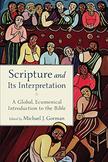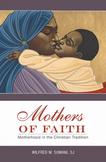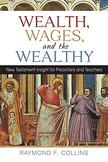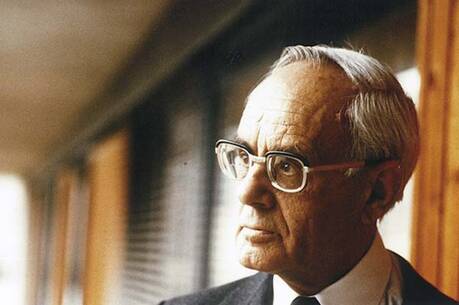
Books on the Bible 2018: Fresh perspectives on sacred texts
This year’s selection of noteworthy books on the Bible reflects current approaches to biblical writings, such as a focus on the history of their reception as well as new emphasis on theological and ecological readings of the texts. The selection also includes books that deal with some pressing questions asked about biblical writings, such as reconciliation of the biblical discourses with experimental sciences and what the Bible has to say about wealth and poverty.
The originality of its design, its wealth of information, its breadth and its accessible language make Scripture and Its Interpretation: A Global, Ecumenical Introduction to the Bible (Baker Academic, 2017), edited by Michael J. Gorman, stand apart among the large number of general introductions to the Bible available to readers. The volume is designed as a textbook, with each of 24 chapters written by a different contributor. Each chapter ends with a short annotated bibliography and a list of questions meant to facilitate discussion.
The first part of the book deals with the Bible itself. It describes its character as a book and as a library, its geographical and historical contexts. It also surveys both testaments, explains the formation of the canon and the history of the translation of the Bible and even briefly describes some significant ancient books or collections of books associated with the Bible that are not part of the canon—for example, the Book of Enoch, the Dead Sea Scrolls and the Gospel of Thomas.
While much of that information can be found in other general introductions to the Bible, the second and third parts give this volume its originality. The second part explains the reception and the interpretation of the Bible in various traditions: Protestant, Roman Catholic, Orthodox and Pentecostal traditions, and African, African-American, Latinx and Asian/Asian-American interpretations. Gorman acknowledges lumping together various currents of interpretation in the case of Africa and Asia, but he is to be commended for including these traditions in a one-volume introduction to the Bible. The third part expounds on the relation between Scripture and spirituality, Christian ethics, Christian community and Christian mission. The volume ends with a substantial glossary.
After the broad scope of Gorman’s volume, the next offering focuses on one text, the Book of Samuel, and a political reading of it. Many students of Hebrew texts will remember days and nights devoted to sections of 1-2 Samuel. Not only is the Hebrew style excellent for such learning, but the narrative quality is so elevated that the struggle to read and translate the text is amply rewarded by the many levels of meaning in the text. No wonder there are so many monographs written on Samuel. A recent title demonstrates the depths of interpretive riches for English-only readers of this book: The Beginning of Politics: Power in the Biblical Book of Samuel (Princeton University Press, 2017), by Moshe Halbertal and Stephen Holmes.
Both authors are professors at New York University (not in Hebrew Bible but rather in the School of Law). They boldly profess that the Book of Samuel is “a book about politics...with copious insights into the nature of political power in general.” Their approach differs radically from many biblicists’ studies (whether the text is pro-David, anti-Saul, from different eras or ‘schools’ in Israel), in that they propose successive portraits of the workings of power in human relations and trace them in stories of Saul and David, of Jonathan and Joab, of the intervention of Abigail, of Uriah’s murder and the rape of Tamar, the death of Amnon and the rebellion of Absalom. At times their unraveling of a well-known story (e.g. the rape of Tamar) is absolutely riveting, and convincing because they have consulted and incorporated the results of so many biblical studies of this text.
The authors begin by describing the dramatic theological shift encompassed in the Book of Samuel, from an older view of monarchy as part of the cosmic mythical order common in the Ancient Near East, where kingship was deified, to a new order and theology where “God is king” and kingship was “an institution…voluntarily embraced for strategic reasons in historical time.” Within this human institution, the play of power and pathos make for a story that is decidedly political and clearly theological at the same time.
The next offering takes readers to the Wisdom corpus of the Old Testament. Many educated Catholics express dismay with the Old Testament because the subject matter seems too foreign to them or the historical texts are too confusing. But many also find the militarism and the praise of a divine warrior God who saved the Hebrew refugees from Egypt disgusting. Few have any awareness of the Wisdom books or what they might signify. John McLaughlin’s new book, An Introduction to Israel’s Wisdom Traditions (William B. Eerdmans Publishing Company, 2018), could prove quite helpful.
Some people may find surprising and useful the literature described as “Wisdom” oriented, much of which contains little or no historical reference to God’s “mighty acts” for the people of Israel. These books—Proverbs, Job, Qoheleth, Ben Sira and the Wisdom of Solomon—form the core of the Wisdom tradition. Here the questions of everyday life, including family, marketplace and human relationships, take center stage; many readers will be surprised to learn how divine presence and activity is discerned in these texts.
The Wisdom corpus of the Old Testament—Proverbs, Job, Qoheleth, Ben Sira and the Wisdom of Solomon—form the core of the Wisdom tradition. Here the questions of everyday life, including family, marketplace and human relationships, take center stage.
McLaughlin discusses this literature with a clarity that does not sacrifice the complexity of the issues. He introduces the Wisdom influences for the Ancient Near Eastern cultures, and demonstrates their importance in the literature of the Dead Sea Scrolls and some early Jewish literature and the New Testament. This text will serve as a valuable reference to return to frequently.
The next book experiments with feminist-inspired readings of texts of the Apocrypha and other Early Jewish texts. Early Jewish Writings (The Bible and Women: An Encyclopedia of Exegesis and Cultural History; Volume 3.1, SBL Press, 2017), edited by Eileen Schuller and Marie-Theres Wacker, features essays on books considered as Apocrypha (LXX Esther, Judith, Letter of Jeremiah) and some classified as Pseudepigrapha (Joseph and Aseneth, the Life of Adam and Eve, 1 Enoch). In addition, there are essays that plumb the texts of Philo and Josephus. It concludes with an essay that surveys the Dead Sea Scrolls in terms of gender and sectarian identity: “The World of Qumran and the Sectarian Dead Sea Scrolls in Gendered Perspective,” by Maxine Grossman. This essay was the high point, because it looks at such a wide range of Qumran texts and through a special perspective.
At first glance Mothers of Faith: Motherhood in the Christian Tradition (Orbis Books, 2017), by Wilfred M. Sumani, appears to be a book about biblical characterization of mothers. Closer contact reveals a book of meditations and theological reflections on mothers encountered in the Bible (Old and New Testament) and in early Christian tradition. Finally, Part IV, “Motherhood as Theological Analogy,” features God as “Mother of Compassion,” Jesus as the “The Gathering Mother,” the Holy Spirit as “Mother of Newness” and Earth as the “Nurturing Mother.” Sumani describes this section as a mirror of important qualities of God, which also constitutes a presentation of the sacramental character of motherhood.
The “biblical mothers” (Eve, Sarah, Hagar, Rebekah, Leah and Rachel, Hannah, the Widow of Zarephath, the Mother of the Maccabean Brothers; Elisabeth, the Widow of Nain, Zebedee’s Wife, the Syro-Phoenician Woman and Mary the “Mother of Meditation”) also receive treatment. Each chapter offers a literary presentation of the narrative about each mother. Sumani searches for a dominant motif and interprets the mother with generous use of patristic materials (especially John Chrysostom) and focused insights from African culture and customs. These last illustrations often form the most powerful witness to the mother in question. The tone and the elements of his presentation make this book on “Mothers of Faith” a delight to read and especially to ponder in a meditative fashion.
Our next book focuses on figurative language in the Bible. As the Gospel according to Mark has it, Jesus did not speak to the crowds without a parable (Mk 4:34b). Yet this mode of speech can be opaque for the audience, which “hears but does not understand” (Mk 4:12). It is therefore not surprising that these short stories—sometimes one-liners—have piqued the imagination of Christians from all places and all generations. David Gowler’s book, The Parables After Jesus: Their Imaginative Receptions Across Two Millennia (Baker Academic, 2017), explores the diversity of reactions to the parables from the second to the 21st century.
Not only do the reactions compiled in the volume include those of early, medieval and modern church writers (Augustine, Macrina the Younger, Hildegard von Bingen, Thomas Aquinas, Calvin and Luther) and biblical scholars (Adolf Jülicher, David Flusser) but also those of artists in the areas of visual arts (Byzantine iconography, Rembrandt, William Blake), music (“Godspell,” blues music) and literature (Shakespeare, Frederick Douglass, Flannery O’Connor). In all, one finds 50 modes of reaction to the parables.
The condemnation of greed is an integral part of the Gospel: Nineteen passages of the New Testament speak about greed. By comparison, only three passages of the N.T. speak about homosexuality, an issue that draws disproportionate attention in some Catholic circles.
In each case, Gowler considers how the author, artist or tradition enters into dialogue with the parable, whether it shows an attempt to control or restrain the meanings of the parables, whether it tries to solve the enigmas and challenges posed in the parables, and what kind of response it gives to the parables. Gowler is also attentive to the context of these various interpreters.
After the publication of “Laudato Si’,” Pope Francis was criticized for entering onto the turf of economy by some who consider the pope’s jurisdiction limited to the proclamation of the Gospel, a gospel assumed to be silent about the uses and misuses of wealth. As Raymond Collins remarks in Wealth, Wages, and the Wealthy: New Testament Insights for Preachers and Teachers (Liturgical Press, 2017), the problem is that the condemnation of greed is an integral part of the Gospel: Nineteen passages of the New Testament speak about greed. By comparison, only three passages of the N.T. speak about homosexuality, an issue that draws disproportionate attention in some Catholic circles.
Collins highlights how each book of the New Testament has something to say about wealth. Each chapter walks the reader through one section of the New Testament and explains pertinent passages. Collins’s study shows how knowledgeable he is about the texts themselves and how well read he is in contemporary biblical scholarship. Each chapter ends with a short discussion of the contemporary relevance of his analysis of these passages of the New Testament, including a final chapter on the uses and misuses of wealth. This is a timely book that has numerous prophetic accents.
Our next book follows on the same topic but focuses on one large section of the New Testament: Luke’s Gospel and Acts of the Apostles, both of which are replete with statements that can make a strong impression upon any committed Christian looking for some guidelines for one’s right attitude toward wealth and poverty. How should one assess the various trends of the Luke-Acts discourse about money and wealth? What in this discourse is relevant and applicable in the 21st-century global context of the academy? After reading Renouncing Everything: Money and Discipleship in Luke (Paulist, 2016), by Christopher M. Hays, one will likely not have a definitive answer to all these questions, as Thomas J. Massaro, S.J., notes in his foreword to the book, but one will understand better the nuances of Luke-Acts discourse on wealth and money.
In addition, one will gain some sense of how this discourse fits within the pursuit of the kingdom of God in one’s daily life. Based on Hays’s doctoral dissertation, this slim and very readable volume explains the various ways one can understand and apply this discourse, depending of one’s situation—as long as it is motivated by Jesus’ double love command in Luke: “You shall love the Lord your God with all your heart, and with all your soul, and with all your mind; and you shall love your neighbor as yourself” (Lk 10:27, conflating Dt 6:5 and Lv 19:18).
The New Testament scholar Dale B. Martin has ventured away from his usual turf in Biblical Truths: The Meaning of Scripture in the Twenty-First Century (Yale University Press, 2017). This insightful work contains Martin’s experiments in theological interpretation of Scripture that are mostly not derived from the use of historical methods and historical criticism. Rather, Martin self-consciously adopts a premodern approach, that is, an approach that does not distinguish between theological and biblical scholarship. He aims at offering a nonfoundationalist, postmodern, Marxist, orthodox, ecumenical and provisional interpretation of the New Testament that, albeit being influenced by Protestantism (especially Anglicanism), will be recognized as orthodox by Roman Catholics and Eastern Orthodox. The volume takes the reader through various aspects of the Christian faith—namely, knowledge, Scripture, God, Christ, Spirit, human and church. It is well informed by the author’s broad knowledge of the historical and cultural context in which the writings of the New Testament came into existence—even if this kind of information is subservient to the theological impetus of the book.
How would St. Paul describe himself if he were to have his own LinkedIn page?
Now we turn to a very specific biblical personage: St. Paul. How would Paul describe himself if he were to have his own LinkedIn page? One can guess that he would use the terms apostle, missionary and theologian that have come to be associated with him in Christianity. To these terms, he would also add the label “pastor,” because all his letters are meant to nurture the life of Christian communities and/or to attend to the needs of specific individuals (e.g., Onesimus and Philemon). Yet, as Andrew Lincoln remarked in 1989, while there is an abundance of books on Paul and his letters, they generally overlook his role as a pastor.
Paul as a Pastor (Bloomsbury T&T Clark, 2018), a collection of essays edited by Brian S. Rosner, Andrew S. Malone and Trevor J. Burke, intends to fill this lacuna by studying Paul the pastor from exegetical, theological and historical angles. One essay focuses on the portrayal of Paul as a pastor in the Acts of the Apostles; another on Paul as a working pastor (tentmaker) while three other essays discuss the perspective of Paul as a pastor in the Church of England, in the works of Augustine of Hippo and in the work of George Whitefield (1714-70), one of the founders of Methodism. The essays that focus on the letters highlight their rich relational language as an important feature of Paul’s representation as a pastor.
Still, beyond a few passages, Catholics tend not to be very familiar with Paul’s letters. Thomas D. Stegman, S.J., explains this lack of familiarity by the way the readings from Paul’s letters are integrated into the liturgy: that is, without offering intentional points of contact with the other readings and by the difficulty of these letters in comparison with the stories of the Gospels. Stegman’s book Written for Our Instruction: Theological and Spiritual Riches in Romans (Paulist Press, 2017) attempts to alleviate this lack of familiarity concerning one of the most daunting among Paul’s letters—a letter that nevertheless has much to offer to contemporary believers and that also resonates in the teachings of Pope Francis. Each chapter of the book deals with a different aspect of Romans by seeing what it has to say about God, Jesus, the Spirit, salvation and church. Each chapter also ends with 10 questions for prayer and reflection. As Stegman confesses, this book is no substitute for reading the letter to the Romans, but it offers a helpful guide for this endeavor.
Christians often have difficulty reconciling the Genesis creation account of humanity with scientific discoveries about the origins of the human species. Accordingly, it is not uncommon for these Christians to feel that they must choose between two camps: either the Genesis story or evolutionary biology. Some avoid this decision by compartmentalizing these two beliefs. Dennis R. Venema and Scot McKnight’s book Adam and the Genome: Reading Scripture after Genetic Science (Brazos Press, 2017) puts these two perspectives into dialogue. The originality of this endeavor partially resides with the disciplines of the two authors. Venema is a professor of biology at Trinity Western University (British Columbia) and specializes in genetics. McKnight is a professor of biblical studies at Northern Seminary (Illinois).
Both authors are evangelical Christians, but the questions they address are widespread across most Christian denominations. Venema wrote the first four chapters of the book, a crash course on contemporary genetics and its contribution to the understanding of the origins of the human species. Venema patiently explains major concepts in contemporary genetics using numerous analogies. McKnight wrote the remaining four chapters. He contends that once read with awareness of the initial context in which the stories found in Genesis came into existence as well as the various contexts in which Genesis has been interpreted, these stories provide fresh ways of interacting with science today. For instance, McKnight counterintuitively (and by contrast to the subtitle of the book) upholds the primacy of Scripture but considers that Scripture should always be read as the point of departure toward other books—the study of nature being one of these other texts.
In many ways we live in an apocalyptic world: Burning forests, flooded territories, contaminated lands and waters surround us; the gap between rich and poor has become a chasm; and truth is not truth anymore.
Many scientists have written books on the relation between the Bible and evolution, but Lester Grabbe’s book, Faith & Fossils: The Bible and Creation & Evolution (William B. Eerdmans Publishing Company, 2018), might be the first book by a biblical specialist to address the topic at such length. In the first section he describes his own journey from Bible Belt conservatism to a deeper knowledge of ancient civilizations and reading the Bible in its original languages. As a noted biblical scholar who no longer identifies as an evangelical Christian, he still considers their questions to be very important.
In the first part he provides lucid interpretation of three key texts in the discussion: the creation account in Genesis 1; the account of the Flood in Genesis 6-9; and the notion of “after its/their kind” in Genesis 1. While some evangelicals try to accommodate notions of science with these texts, he demonstrates the artfulness and poetry of the biblical texts and the great distinction from scientific description. He bypasses the technical language of literary sources of many biblical scholars.
In Part Two he discusses the conversation between science and religion, between the Bible and evolution, addressing the claims of Richard Dawkins in the discourse of biologists, paleontologists and geologists on this topic. Readers will appreciate the vast survey of contemporary voices in this debate, though they might regret the seeming lack of Catholic voices other than Pierre Teilhard de Chardin, S.J. For those of us primarily interested in the Bible, Grabbe offers an excellent chapter on “How We Got the Bible” and how that process affects our understanding of these realities.
The Book of Revelation provides hope for its initial audience by describing how God will renovate and renew creation rather than discarding it.
Let us move to the other end of the Bible. In many ways we live in an apocalyptic world: Burning forests, flooded territories, contaminated lands and waters surround us; the gap between rich and poor has become a chasm; and truth is not truth anymore. This can make us feel hopeless and guilty about leaving our children such a dire place as an inheritance. In that context the title of Micah D. Kiel’s book, Apocalyptic Ecology: The Book of Revelation, the Earth, and the Future (Liturgical Press, 2017), sounds like the ultimate oxymoron. Taking a counterintuitive approach, Kiel argues that the book of Revelation elaborates a completely new reality, which is what we need to survive our contemporary ecological crisis and to regain hope for our future.
The author confesses that writing this book has changed him and hopes that readers will experience the same type of change once they understand Revelation better in light of modern ecology. Kiel’s work combines a rigorous study of Revelation and a creative dialogue between its response to the ecological situation in which it came into existence and what could be our response to the contemporary ecological crisis. All this written in a lively and accessible prose. To help appreciate Revelation, Kiel first examines 1 Enoch, one of Revelation’s ancestors that already gives the earth a voice in a context of Hellenistic wars. Kiel next explains the lasting impact of the Roman empire: deforestation to build military fleets and war machines, water pollution through mining and large-scale extermination of wild animals in circus games. The scenes of destruction described in Revelation are therefore not predictions of future events. They rather describe the actual situation of its first audience.
Revelation provides hope for its initial audience by describing how God will renovate and renew creation rather than discarding it. Medieval interpreters who illuminated manuscripts expressed this hope for renewal by paying far more attention to the representation of the natural world than to scenes of destruction. In Kiel’s words, they understood how the book “calls us to contemplate the world around us to come to grips with the way all things are connected. God, humans, and creation are all entangled together.”
This article also appeared in print, under the headline “Fresh perspectives on sacred texts,” in the December 24, 2018, issue.












